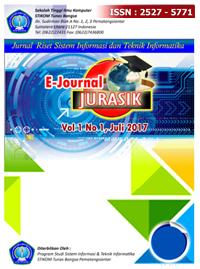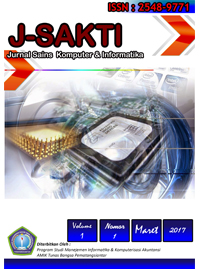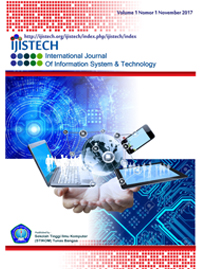Memprediksi Faktor Tunggakan Uang Kuliah Menggunakan Metode Naive Bayes
Abstract
Full Text:
PDFReferences
S. Endriani, “ISSN 1412-1395 (cetak) 2355-3529 (elektronik),” vol. 15, pp. 70–75, 2015.
A. Saleh, “Implementasi Metode Klasifikasi Naïve Bayes Dalam Memprediksi Besarnya Penggunaan Listrik Rumah Tangga,” no. January 2015, 2016.
A. P. Windarto, D. Hartama, and N. Dalimunthe, “Model Arsitektur Backpropogation Dalam Memprediksi Faktor Tunggakan Uang Kuliah (Studi Kasus AMIK Tunas Bangsa),” in Seminar Nasional Multidisiplin, 2017, pp. 1–9.
Y. sulistio Nugroho, “Penerapan Algoritma C4.5 untuk Klasifikasi Predikat Kelulusan Mahasiswa Fakultas Komunikasi dan Informatika Universitas Muhammadiyah Surakarta,” Prosiding Seminar Nasional Aplikasi Sains & Teknologi (SNAST), no. November, pp. 1–6, 2014.
C. Fadlan, S. Ningsih, and A. P. Windarto, “PENERAPAN METODE NAÏVE BAYES DALAM KLASIFIKASI KELAYAKAN KELUARGA PENERIMA BERAS RASTRA,” JUTIM, vol. 3, no. 1, pp. 1–8, 2018.
I. Parlina, A. P. Windarto, A. Wanto, and M. R. Lubis, “Memanfaatkan Algoritma K-Means dalam Menentukan Pegawai yang Layak Mengikuti Asessment Center untuk Clustering Program SDP,” CESS (Journal of Computer Engineering System and Science), vol. 3, no. 1, pp. 87–93, 2018.
M. G. Sadewo, A. P. Windarto, and A. Wanto, “Penerapan Algoritma Clustering dalam Mengelompokkan Banyaknya Desa/Kelurahan Menurut Upaya Antisipasi/ Mitigasi Bencana Alam Menurut Provinsi dengan K-Means,” KOMIK (Konferensi Nasional Teknologi Informasi dan Komputer), vol. 2, no. 1, pp. 311–319, 2018.
S. Sudirman, A. P. Windarto, and A. Wanto, “Data Mining Tools | RapidMiner : K-Means Method on Clustering of Rice Crops by Province as Efforts to Stabilize Food Crops In Indonesia,” IOP Conference Series: Materials Science and Engineering, vol. 420, no. 12089, pp. 1–8, 2018.
R. W. Sari, A. Wanto, and A. P. Windarto, “Implementasi Rapidminer dengan Metode K-Means (Study Kasus : Imunisasi Campak pada Balita Berdasarkan Provinsi),” KOMIK (Konferensi Nasional Teknologi Informasi dan Komputer), vol. 2, no. 1, pp. 224–230, 2018.
T. Badan, J. Hb, and M. A. Posteriori, “Klasifikasi Naïve Bayes untuk Prediksi Kelahiran pada Data Ibu Hamil,” vol. 23, no. September, pp. 297–308, 2013.
DOI: http://dx.doi.org/10.30645/senaris.v1i0.35
Refbacks
- There are currently no refbacks.
 








